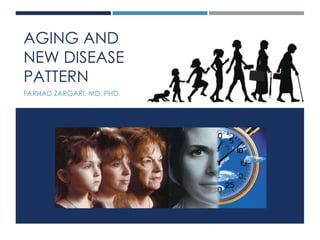
Aging and New Disease Pattern
- 1. AGING AND NEW DISEASE PATTERN FARHAD ZARGARI, MD, PHD
- 3. NEW DISEASE PATTERNS The improvements in healthcare are part of a major transition in human health spreading around the globe at different rates and along different pathways. This transition encompasses a broad set of changes that include a decline from high to low fertility; a steady increase in life expectancy at birth and at older ages; and a shift in the leading causes of death and illness from infectious and parasitic diseases to non- communicable diseases and chronic conditions.
- 4. NEW DISEASE PATTERNS The transition from high to low mortality and fertility that accompanied socioeconomic development has also meant a shift in the leading causes of disease and death. Demographers and epidemiologists describe this shift as part of an “epidemiologic transition” characterized by the waning of infectious and acute diseases and the emerging importance of chronic and degenerative diseases.
- 5. NEW DISEASE PATTERNS High death rates from infectious diseases are commonly associated with the poverty, poor diets, and limited infrastructure found in developing countries. Although many developing countries still experience high child mortality from infectious and parasitic diseases, one of the major epidemiologic trends of the current century is the rise of chronic and degenerative diseases in countries throughout the world— regardless of income level.
- 6. NEW DISEASE PATTERNS Over the next 10 to 15 years, people in every world region will suffer more death and disability from such non-communicable diseases as heart disease, cancer, and diabetes than from infectious and parasitic diseases.
- 7. NEW DISEASE PATTERNS Arthritis 50 54 Hypertension Heart 36 32 39 39 Hearing Cataracts 28 16 36 24 Diabetes Vision 10 8 11 11 Burden of Chronic Non-communicable Diseases Condition Age 65 % Age 75 %
- 8. NEW DISEASE PATTERNS By 2030, non-communicable diseases are projected to account for more than one-half of the disease burden in low-income countries and more than three-fourths in middle-income countries. >50% >75% 2030 DevelopedDeveloping
- 9. NEW DISEASE PATTERNS Infectious and parasitic diseases will account for 30 percent and 10 percent, respectively, in low- and middle-income countries. Among the 60-and-over population, non-communicable diseases already account for more than 87 percent of the burden in low-, middle-, and high-income countries.
- 10. NEW DISEASE PATTERNS The Increasing Burden of Chronic Non-communicable Diseases: 2008 and 2030 Source: World Health Organization, Projections of Mortality and Burden of Disease, 2004-
- 11. NEW DISEASE PATTERNS And, there is growing evidence that older people are particularly susceptible to infectious diseases for a variety of reasons, including immune-senescence (the progressive deterioration of immune function with age) and frailty. Older people already suffering from one chronic or infectious disease are especially vulnerable to additional infectious diseases. For example, type 2 diabetes and tuberculosis are well- known “comorbid risk factors” that have serious health consequences for older people.
- 12. CHILDHOOD-OLD AGE HEALTH LINKAGE A growing body of research finds that health problems in adulthood and old age stem from infections and health conditions early in life. Some researchers argue that important aspects of adult health are determined before birth, and that nourishment in utero and during infancy has a direct bearing on the development of risk factors for adult diseases—especially cardiovascular diseases. Early malnutrition in Latin America is highly correlated with self-reported diabetes, for example, and childhood rheumatic fever is a frequent cause of adult heart disease in developing countries.
- 13. CHILDHOOD-OLD AGE HEALTH LINKAGE Research also shows that delayed physical growth in childhood reduces physical and cognitive functioning in later years. Data on China’s oldest old show that rarely or never suffering from serious illnesses or receiving adequate medical care during childhood results in a much lower risk of suffering cognitive impairments or physical limitations at ages 80 or older.
- 14. CHILDHOOD-OLD AGE HEALTH LINKAGE Probability of Being Disabled among Elderly in Seven Cities of Latin America and the Caribbean (2000) and Puerto Rico (2002-2003) by Early Life Conditions Source: Monteverde M, Norohna K, Palloni A. 2009. Effect of early conditions on disability among the elderly in Latin-America and the Caribbean. Population Studies 2009;63/1: 21-
